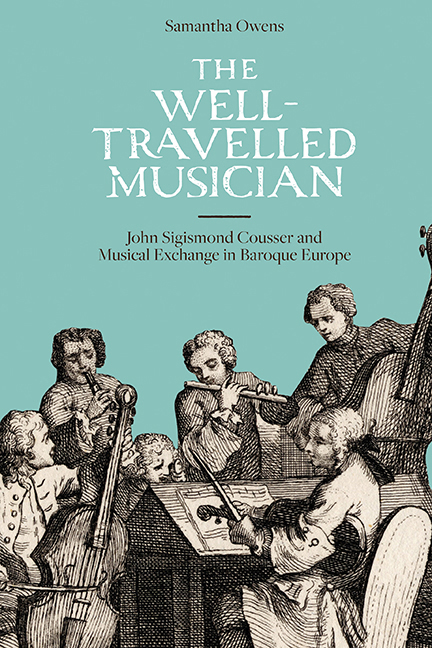Book contents
- Frontmatter
- Dedcation
- Contents
- List of Tables
- Preface
- Abbreviations
- Notes on Sources
- Introduction: John Sigismond Cousser and his ‘Commonplace Book’
- 1 Hungarian Beginnings and the Adoption of French Musical Style
- 2 Kapellmeister at the Wolfenbüttel Court and Braunschweig Opera House
- 3 Ariadne to Porus: Cousser's Braunschweig Operas
- 4 ‘The Incomparable Director’ in Hamburg, Nuremberg and Augsburg
- 5 Heliconische Musen-Lust: Opera at the Württemberg Court
- 6 ‘Il Paradiso terrestre’? Cousser in London
- 7 ‘Fortune not Blind’: Music for Dublin Castle
- 8 ‘Our Concert’: A Musician at Home
- 9 Cousser's ‘collection of fine musick’ and the Practicalities of Musical Exchange
- Appendix 1 Summary of the Contents of Cousser's ‘Commonplace Book’
- Appendix 2 Cousser's Address Book
- Appendix 3 Cousser's Books of Cantatas, Madrigals, Duets and Serenatas
- Appendix 4 Cousser's Inventory of Ouverture Incipits
- Appendix 5 Transcription of Cousser's Notes for his 1716 Trip to London and the Continent
- Bibliography
- Index
- Titles listed here were originally published under the series title Music in Britain, 1600–1900
- New titles published under the series title Music in Britain, 1600–2000
Introduction: John Sigismond Cousser and his ‘Commonplace Book’
Published online by Cambridge University Press: 30 August 2019
- Frontmatter
- Dedcation
- Contents
- List of Tables
- Preface
- Abbreviations
- Notes on Sources
- Introduction: John Sigismond Cousser and his ‘Commonplace Book’
- 1 Hungarian Beginnings and the Adoption of French Musical Style
- 2 Kapellmeister at the Wolfenbüttel Court and Braunschweig Opera House
- 3 Ariadne to Porus: Cousser's Braunschweig Operas
- 4 ‘The Incomparable Director’ in Hamburg, Nuremberg and Augsburg
- 5 Heliconische Musen-Lust: Opera at the Württemberg Court
- 6 ‘Il Paradiso terrestre’? Cousser in London
- 7 ‘Fortune not Blind’: Music for Dublin Castle
- 8 ‘Our Concert’: A Musician at Home
- 9 Cousser's ‘collection of fine musick’ and the Practicalities of Musical Exchange
- Appendix 1 Summary of the Contents of Cousser's ‘Commonplace Book’
- Appendix 2 Cousser's Address Book
- Appendix 3 Cousser's Books of Cantatas, Madrigals, Duets and Serenatas
- Appendix 4 Cousser's Inventory of Ouverture Incipits
- Appendix 5 Transcription of Cousser's Notes for his 1716 Trip to London and the Continent
- Bibliography
- Index
- Titles listed here were originally published under the series title Music in Britain, 1600–1900
- New titles published under the series title Music in Britain, 1600–2000
Summary
IN a world where online social networking services allow individuals to connect with countless numbers of people from across the globe (whether family and friends, colleagues or, indeed, complete strangers), it may require some effort to imagine how figures from earlier historical periods created and maintained similarly impressive social and professional networks drawn from across wide geographical expanses. Yet while such networking may not have been achieved through the relative ease of the click of a mouse, the early modern period nevertheless witnessed an increase in the exchange of information and opinions across diverse levels of society through a variety of means. Chief among these was the method of travel, with the early eighteenth century in particular being a time of increased mobility in Europe, with aristocrats, intellectuals and merchants being far from the only groups to travel regularly or settle permanently abroad. Indeed, as Margrit Schulte Beerbühl has pointed out, the spread of cosmopolitanism during this period can equally be observed in ‘A German baker or pork butcher who introduced German bakery goods or German sausages into England, or an Italian chocolate-maker who settled in Germany.’
Musicians were among those members of early modern society who travelled frequently and whose profession allowed them access to a variety of social classes. Such circumstances created conditions perfect for the two chief national musical styles of the Baroque era – the French and the Italian – to intermingle and eventually lead to what Johann Joachim Quantz famously (if somewhat nebulously) described as a ‘mixed taste’ (‘vermischter Geschmack’). In purely practical terms, at the level of individuals this meant that working musicians or musicians-in-training considered it reasonably commonplace to venture abroad for further study or for more advantageous professional conditions, whether by attracting highly paid employment at the court of a wealthy German prince or by seeking to exploit the commercial opportunities on offer in a major European city such as London (as was recommended by Johann Mattheson in 1713), to give but two of the numerous possibilities through which such professionals sought to improve their lot in life.
John Sigismond Cousser (1660–1727) was one such well-travelled musician, whose lengthy career offers numerous concrete examples of the ways in which Baroque musical styles were disseminated across national borders, or, indeed, spread across disparate regions in a single nation state.
- Type
- Chapter
- Information
- The Well-Travelled MusicianJohn Sigismond Cousser and Musical Exchange in Baroque Europe, pp. 1 - 8Publisher: Boydell & BrewerPrint publication year: 2017



